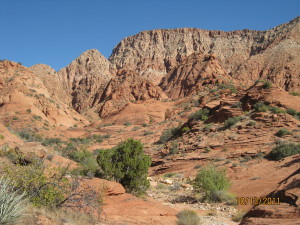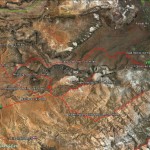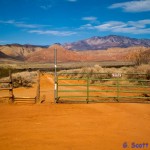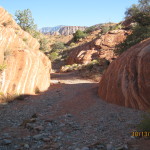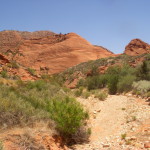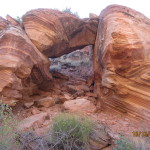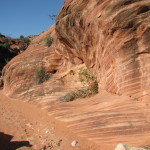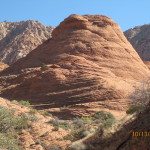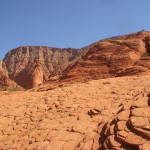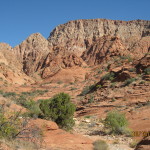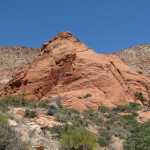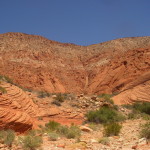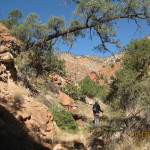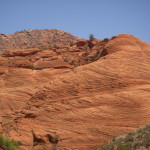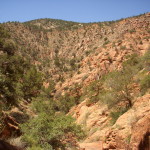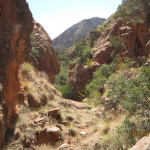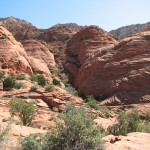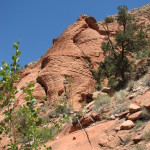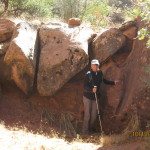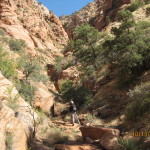Washington Hollow
Only lightly visited, the Washington Hollow trail provides visitors with one of the outstanding wilderness experiences in the Red Cliffs Desert Reserve. The trail is usually accessed from the Mill Creek trailhead which entails a 2-mile walk on a city maintenance road that serves a powerline and several pump houses north of the city of Washington, Utah. At the end of the maintenance road, hikers and equestrians will drop down into a wash bottom and follow the drainage for up to four miles before a series of dry falls makes it too difficult for most to continue. Bicycles are not allowed to enter the Cottonwood Canyon Wilderness Area. Due to narrow canyon walls and dense vegetation, horses will not progress into the uppermost portions of the canyon. Elevation gain throughout the hike is a gentle 800 feet with no serious ups and downs. The wash bottom consists of a sandy soil mixed with gravel and cobble-sized rocks which makes for relatively easy hiking. Throughout the middle portion of the canyon, visitors will enjoy spectacular views of red and white sandstone peaks and formations and unusual displays of color and form that only nature can envision. The upper canyon narrows considerably and, other than occasional slot canyon segments, diminishes the ability of visitors to observe some of the unique twists and turns of the wilderness environment unless the visitors leave the main wash to enter side canyons or higher ground to witness the breadth and beauty of the upland formations. Most visitors will need to exit the canyon the same way they came in, making it an out-and-back of 12 miles to the Mill Creek trailhead if they travel to the northernmost end. Hikers and riders should avoid the canyon during rain events due to the likelihood of flash floods. Lands within the wilderness area are administered by the BLM within the Red Cliffs NCA. Travel along the maintenance road occurs on lands administered by SITLA.
- The Washington Hollow trail map shows its relationship to the Mill Creek trail system.
- The Mill Creek trailhead is most often used as the principal access to Washington Hollow. It entails a two mile hike on a city maintenance road before reaching the start of the actual trail.
- Washington Hollow trail follows the wash bottom which consists primarily of gravely sand mixed with cobbles. Here it enters a small slot canyon early in the hike.
- The lower section of the trail is an open canyon environment with nice views of distant formations.
- Throughout the canyon, visitors may enjoy numerous rock formations including this unique structure that only nature could provide.
- Visitors will see unique colors and striations such as this formation which portrays nature’s art work.
- Throughout the hike visitors will see numerous sandstone monuments such as this one in the middle section.
- Visitors who get above the wash bottom will be treated to numerous sandstone formations that provide opportunities for play within the wilderness area.
- The canyon is best known for the magnificent peaks and cliffs which form the backdrop to the canyon itself.
- This landmark monument is common of the structures that are seen throughout the canyon.
- This spectacular cliff face constitutes the signature view of the Washington Hollow canyon.
- Interesting, if not strange, vegetative formations may be enjoyed through much of the canyon corridor.
- Rock formations such as this sandstone monolith provide wonderful examples of unique sculpturing by mother nature.
- The upper sections of the canyon display pinyon and juniper tree habitat throughout most of its length.
- In places the upper segments take visitors through narrow canyon passages.
- Visitors with time on their hands can take advantage of numerous side canyons for sandstone rock exploration.
- Interesting formations such as this one may also be found in the canyon above the wash bottom.
- Nearly four miles into the hike, visitors will encounter this eight foot rock fall which poses a significant challenge for many hikers.
- For most visitors, this narrow canyon closure, located a short distance beyond the rockfall, represents the end of the trail without significant technical ability and associated equipment.
